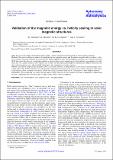Validation of the magnetic energy vs. helicity scaling in solar magnetic structures
Date
10/2014Metadata
Show full item recordAbstract
Aims. We assess the validity of the free magnetic energy - relative magnetic helicity diagram for solar magnetic structures.Methods. We used two different methods of calculating the free magnetic energy and the relative magnetic helicity budgets: a classical, volume-calculation nonlinear force-free (NLFF) method applied to finite coronal magnetic structures and a surface-calculation NLFF derivation that relies on a single photospheric or chromospheric vector magnetogram. Both methods were applied to two different data sets, namely synthetic active-region cases obtained by three-dimensional magneto-hydrodynamic (MHD) simulations and observed active-region cases, which include both eruptive and noneruptive magnetic structures.Results. The derived energy-helicity diagram shows a consistent monotonic scaling between relative helicity and free energy with a scaling index 0.84 +/- 0.05 for both data sets and calculation methods. It also confirms the segregation between noneruptive and eruptive active regions and the existence of thresholds in both free energy and relative helicity for active regions to enter eruptive territory.Conclusions. We consider the previously reported energy-helicity diagram of solar magnetic structures as adequately validated and envision a significant role of the uncovered scaling in future studies of solar magnetism.
Citation
Tziotziou , K , Moraitis , K , Georgoulis , M K & Archontis , V 2014 , ' Validation of the magnetic energy vs. helicity scaling in solar magnetic structures ' , Astronomy & Astrophysics , vol. 570 , L1 . https://doi.org/10.1051/0004-6361/201424864
Publication
Astronomy & Astrophysics
Status
Peer reviewed
ISSN
0004-6361Type
Journal item
Description
V.A. acknowledges support by the Royal Society. This work was supported from the EU’s Seventh Framework Program under grant agreement n° PIRG07-GA-2010-268245. It has been also cofinanced by the European Union (European Social Fund – ESF) and Greek national funds through the Operational Program “Education and Lifelong Learning” of the National Strategic Reference Framework (NSRF) – Research Funding Program: Thales.Collections
Items in the St Andrews Research Repository are protected by copyright, with all rights reserved, unless otherwise indicated.

